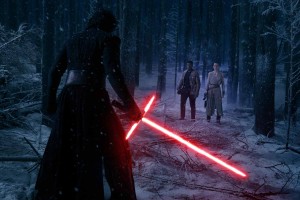
“It was crazy the amount of secrecy that was on the show,” he said – a level perhaps unrivaled by Americans working in London since plans for D-Day were being hatched. But then again, Gilford might have had reason for not wanting to talk too much: “I would’ve done it for free!” he said. “It was really a dream come true for me in every way. I feel like I hit the lottery.”
His road to that particular Powerball ticket might have begun deep in his DNA. As he described it, his father was an automotive designer who then “became the original ‘Hot Wheels’ designer,” staying at Mattel for years. And while Gilford’s own original design dreams initially ran toward cars, too, his dad also “had a huge love of film.”
 That love of film was re-sparked after he found car design “very stagnant,” but loved what he learned about storyboarding and “Imagineering” during an internship at Disney. Breaks kept coming his way as he was introduced to Mike Judge at Fox, after working on a series of commercials, and he found himself doing production design on Judge’s Idiocracy.
That love of film was re-sparked after he found car design “very stagnant,” but loved what he learned about storyboarding and “Imagineering” during an internship at Disney. Breaks kept coming his way as he was introduced to Mike Judge at Fox, after working on a series of commercials, and he found himself doing production design on Judge’s Idiocracy.
And that experience paid off when he reunited with commercial director Joseph Kosinksi, who was doing TRON: Legacy, which Gilford production designed, along with the director’s follow-up, the Tom Cruise-starring Oblivion.
It was the latter film “that caught the eye of Rick Carter,” the industry veteran who’d won an Oscar for Lincoln, and designed genre favorites ranging from the two Back to the Future sequels to Jurassic Park, Avatar, and more.
 Originally, the shared duties would be to “plug holes as needed. He’d go scouting, while I’d stay behind, then we’d switch” That sharing was always meant to be between “equals on paper,” Gilford allowed, “but it couldn’t help but be a mentoring experience.”
Originally, the shared duties would be to “plug holes as needed. He’d go scouting, while I’d stay behind, then we’d switch” That sharing was always meant to be between “equals on paper,” Gilford allowed, “but it couldn’t help but be a mentoring experience.”
But first, Gilford had to survive a four month vetting process – meeting with J.J. Abrams as well as Lucasfilm and Disney executives. Part of what helped was an old Cinefantastique cover – the print magazine that was once the definitive repository for SF, fantasy and horror film coverage – done by his father. To get the cover right, in those pre-internet days, “my dad had to go to the movie theater nine times, to sketch out what a TIE-fighter looks like.” That same issue also had an in-depth look on how the Death Star was designed, something that Abrams really wanted to study. That source material helped convince Abrams that “he’d got the right guy. At least in the beginning,” Gilford laughed.
And as it turned out, all the way through. So was there the same use of repurposed practical sets as there was in the original? The original set was constantly reconfigured. “It had height. It had depth. It had modularity, and they shot it for 20 different scenes.”
 “We didn’t go out as much as you’d think. We took advantage of local locations.” In some cases, very local: “There are big backlots at Pinewood. We were out there multiple times.”
“We didn’t go out as much as you’d think. We took advantage of local locations.” In some cases, very local: “There are big backlots at Pinewood. We were out there multiple times.”
Including for the village of Jakku, a location which opens the film. The main village was decidedly non-local, in Jordan, but the initial firefight and Imperial atrocities which open the film (and sparks John Boyega’s character arc) were “done on the backlot at night.”
Since it was a night sequence, “it was very forgiving. We built big berms and covered them with sand.”
There were also old-school techniques that turned Pinewood’s massive new Q Stage into a forest, with the “artistry of the art direction department” and scenic painters creating a “four-wall painting of deep forest” around the soundstage in about three weeks. From a distance, “it looked beautiful, but if you look closely, it’s a mess.”
 But the interplay between locations, soundstage, the digital work of VFX supervisors Roger Guyett and Pat Tubach at ILM, and Abrams walking that “razor thin line paying homage to the true hardcore fans while setting up these new characters for another generation,” all of it, Gilford said, was “really an amazingly choreographed dance.”
But the interplay between locations, soundstage, the digital work of VFX supervisors Roger Guyett and Pat Tubach at ILM, and Abrams walking that “razor thin line paying homage to the true hardcore fans while setting up these new characters for another generation,” all of it, Gilford said, was “really an amazingly choreographed dance.”
A dance he was also able to pass along, father-to-child: “My proudest moment was sitting next to my 10 year-old daughter, seeing her connection to (Daisy Ridley’s) Rey. That was pretty magical.”
Meanwhile, Gilford next turns his own “magic” to a Kingsman sequel. “I’ve had a really blessed career. I’m really lucky,” he said. “I love having gone from Idiocracy to Star Wars in two movies.”
Clearly a sign of a design force awakening.





